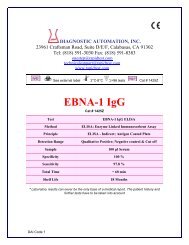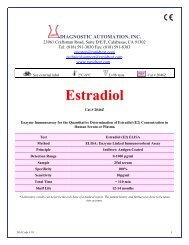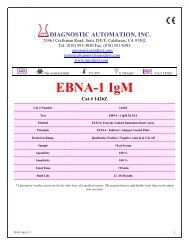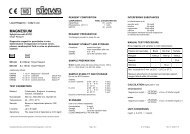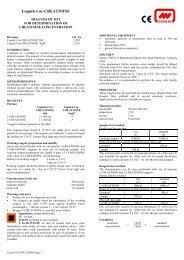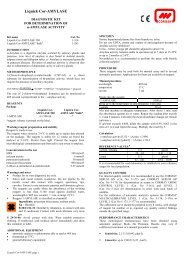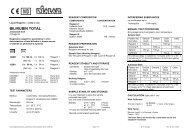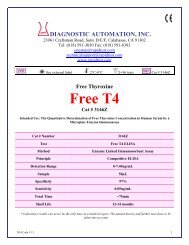CORMAY_CRP ULTRA_1_a
CORMAY_CRP ULTRA_1_a
CORMAY_CRP ULTRA_1_a
You also want an ePaper? Increase the reach of your titles
YUMPU automatically turns print PDFs into web optimized ePapers that Google loves.
<strong>CORMAY</strong> <strong>CRP</strong> <strong>ULTRA</strong><br />
DIAGNOSTIC KIT<br />
FOR DETERMINATION OF C-REACTIVE<br />
PROTEIN CONCENTRATION<br />
Kit name Kit size Cat. No<br />
<strong>CORMAY</strong> <strong>CRP</strong> <strong>ULTRA</strong> 1 x 95 ml 6-300<br />
INTRODUCTION<br />
<strong>CRP</strong> (C-reactive protein) is an acute phase protein whose<br />
concentration is seen to increase as a result of the inflammatory<br />
process, most notably in response to pneumococcal (bacterial)<br />
infectious, histolytic disease and a variety of disease states. <strong>CRP</strong> to<br />
be used as a marker or general diagnostic indicator of infections and<br />
inflammation, in addition to serving as a monitor of patient response<br />
to therapy and surgery. Furthermore, regular measurements of <strong>CRP</strong><br />
in infants can be a useful aid in the early diagnosis of infectious<br />
disease.<br />
METHOD PRINCIPLE<br />
When an antigen-antibody reaction occurs between <strong>CRP</strong> in a sample<br />
and anti-<strong>CRP</strong> antibody which has been sensitized to latex particles,<br />
agglutination results. This agglutination is detected as an absorbance<br />
change (572 nm), with the magnitude of the change being<br />
proportional to the quantity of <strong>CRP</strong> in the sample. The actual<br />
concentration is then determined by interpolation from a calibration<br />
curve prepared from calibrators of know concentration.<br />
REAGENTS<br />
Package<br />
1-Reagent<br />
2-Reagent<br />
1 x 46.5 ml<br />
1 x 48.5 ml<br />
The reagents are stable up to the kit expiry date printed on the<br />
package when stored at 2-10 C. The reagents are stable for 11 weeks<br />
on board the analyser at 2-10 C. Protect from light and avoid<br />
contamination!<br />
Concentrations in the test<br />
suspension of latex particles sensitized with<br />
anti-<strong>CRP</strong> antibodies (rabbit) (pH 7.3)<br />
glycine buffer solution (pH 7.0)<br />
0.20 w/v%<br />
Warnings and notes<br />
• Product for in vitro diagnostic use only.<br />
• After measurements are taken, reagent bottles should be capped<br />
and kept at 2-10 C. Care should be taken not to interchange the<br />
caps of reagent bottles.<br />
• Reagents with different lot numbers should not be interchanged<br />
or mixed.<br />
• The reagents contain sodium azide (< 0.1%) as a preservative.<br />
Avoid contact with skin and mucous membranes.<br />
SPECIMEN<br />
Serum or plasma (Na-EDTA, K-EDTA, Na-Heparin, Li-Heparin,<br />
citrate).<br />
If the test cannot be done immediately, the sample should be placed<br />
in a tightly sealable container and stored at -20 C. Repeated freezing<br />
and thawing should be avoided.<br />
Nevertheless it is recommended to perform the assay with freshly<br />
collected samples!<br />
PROCEDURE<br />
The reagents are ready to use.<br />
These reagents may be used in automatic analysers according to their<br />
user manual. Applications for analysers are available on request.<br />
These reagents may be used directly in Hitachi 911/912 analysers.<br />
Application should be entered using handheld barcode scanner and<br />
attached barcodes sheet, according to procedure described below:<br />
1. Delete previous version of application and calibrators assigned to<br />
it and restart the analyser.<br />
2. Enter codes of calibrators according to the attached list.<br />
3. Enter barcoded application and assign proper values to<br />
calibrators.<br />
4. To activate entered application go to the tab UTILITY |<br />
APPLICATION | RANGE and change value of field DATA<br />
MODE from INACTIVE to ON BOARD. Confirm the change<br />
using UPDATE button.<br />
5. Put reagents on board the analyser – they will be assigned to<br />
relevant tests automatically. Perform also measurement of level<br />
of reagents inside the bottles.<br />
6. After calibration analyser is ready to use.<br />
REFERENCE VALUES 3, 4<br />
serum, plasma<br />
adults<br />
< 0.5 mg/dl (< 5 mg/l)<br />
children (2 months – 15 years) 0.01 – 0.28 mg/dl (0.1 – 2.8 mg/l)<br />
newborns (0 – 3 weeks) 0.01 – 0.41 mg/dl (0.1 – 4.1 mg/l)<br />
It is recommended for each laboratory to establish its own reference<br />
ranges for local population.<br />
QUALITY CONTROL<br />
For internal quality control it is recommended to use the <strong>CORMAY</strong><br />
IMMUNO-CONTROL I (Cat. No 4-288) with each batch of samples.<br />
For the calibration of automatic analysers systems the <strong>CORMAY</strong><br />
<strong>CRP</strong> <strong>ULTRA</strong> CALBRATORS kit (Cat. No 4-276) is recommended.<br />
Calibrators and 0.9% NaCl should be used for calibration.<br />
The calibration curve should be prepared every 3 weeks, with every<br />
change of reagent lot number or as required e.g. quality control<br />
findings outside the specified range.<br />
PERFORMANCE CHARACTERISTICS<br />
These metrological characteristics have been obtained using the<br />
automatic analysers Hitachi 912 and Hitachi 917. Results may vary if<br />
a different instrument is used.<br />
• Sensitivity: 0.1 mg/dl<br />
• Linearity: up to 32 mg/dl.<br />
For higher concentrations dilute the sample with 0.9% NaCl and<br />
repeat the assay. Multiply the result by dilution factor.<br />
• Specificity / Interferences<br />
Haemoglobin up to 0.5 g/dl, bilirubin up to 30 mg/dl,<br />
triglycerides up to 500 mg/dl and RF up to 500 IU/ml do not<br />
interfere with the test.<br />
• Precision<br />
Repeatability (run to run)<br />
n = 20<br />
level 1<br />
level 2<br />
Reproducibility (day to day)<br />
n = 21<br />
level 1<br />
level 2<br />
level 3<br />
Mean<br />
[mg/dl]<br />
3.93<br />
10.75<br />
Mean<br />
[mg/dl]<br />
0.047<br />
0.218<br />
0.976<br />
SD<br />
[mg/dl]<br />
0.06<br />
0.22<br />
SD<br />
[mg/dl]<br />
0.003<br />
0.007<br />
0.012<br />
CV<br />
[%]<br />
1.45<br />
2.00<br />
CV<br />
[%]<br />
6.97<br />
3.34<br />
1.23<br />
<strong>CORMAY</strong> <strong>CRP</strong> <strong>ULTRA</strong> page 1
• Method comparison<br />
A comparison between <strong>CRP</strong> values determined at Hitachi 912 (y) and<br />
at Cobas Integra 400 (x) using 39 samples gave following results:<br />
y = 1.0274 x + 0.0479 mg/dl;<br />
R = 0.9972<br />
(R – correlation coefficient)<br />
WASTE MANAGEMENT<br />
Please refer to local legal requirements.<br />
LITERATURE<br />
1. Tillet W. S. et al.: Serological reactions in pneumonia with a<br />
non-protein somatic fraction of pneumococcus., J. Exp. Med.,<br />
52, 561 (1930).<br />
2. Burits C.A, Ashwood M.D.: Tietz Textbook of Clinical<br />
Chemistry. W.B. Saunders, 1994, p.1808.<br />
3. Burtis C.A. Ashwood E.R. Bruns D.E ed. „Tietz Textbook of<br />
Clinical Chemistry and Molecular Diagnostics” 4th ed. PA WB<br />
Saunders, 2006, p.2263.<br />
4. Schlebusch H, Liappis N, Kalina E, Klein G. High Sensitive<br />
<strong>CRP</strong> and Creatinine: Reference Intervals from Infancyto<br />
Childhood. J Lab Med 2002; 26:341-346.<br />
Date of issue: 12. 2012.<br />
MANUFACTURER<br />
PZ <strong>CORMAY</strong> S.A.<br />
22 Wiosenna Street,<br />
05-092 Łomianki, POLAND<br />
tel.: +48 (0) 22 751 79 10<br />
fax: +48 (0) 22 751 79 14<br />
http://www.cormay.pl<br />
<strong>CORMAY</strong> <strong>CRP</strong> <strong>ULTRA</strong> page 2<br />
12/12/12/12






